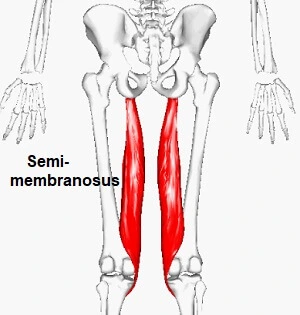25 Best Back Exercises
Table of Contents
Introduction:
- A large, powerful back makes a statement.
- Whether you want to feel better on a daily basis, gain more muscle mass, or perform better under the barbell, every day, you must correctly and consistently exercise your back.
- The activities you select to assist you in reaching your fitness objectives are the first step towards proper back training.
- Often referred to as “pulling movements, “there are more effective back-training exercises than there are back muscles in the top spot.
- Engaging in appropriate exercise can significantly impact your ability to interact with these crucial muscles that you are not able to see in a mirror.
- It is likely that you haven’t discovered the ideal movement yet if your back exercises aren’t working out well.
Anatomy of Back Muscles
The muscles of the back are many and intricate. Some of the back muscles are seen in the figure below; these muscles are readily targeted with the exercises covered in the next portion of this article.
The varying grips, handles, and machines used during training are justified by the fact that the back muscles’ fibers run at different angles, as demonstrated. After all, you want to utilize every muscle fiber possible in your quest for a monster back.
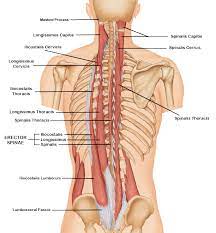
A detailed analysis of every muscle is outside the purview of this piece; in short, the breadth of the back, or the desired v-taper, is the result of the growth of the latissimus dorsi and teres major. On the other hand, the erector spinae and rhomboids that run beneath restore its thickness.
A well-crafted training regimen ought to focus on each of these muscles without creating any imbalances.
Traditionally, the muscles of the back can also be separated into:
- Upper Back: teres, trapezius, rhomboids, and upper latissimus dorsi,
- Lower Back: Lower portions of the erector spinae and lower latissimus dorsi.
The thoracolumbar fascia is connective tissue that cannot be trained on its own; when the erector spinae are well developed, they may be seen “through” it.
You may get the most out of your training by following the detailed workout instruction below, which includes some modifications to focus on both back thickness and width at the same time!
These are the 25 Best Back Exercises:
- Deadlift
- Pull-Up
- Bent-Over Row
- Chest-Supported Row
- Single-Arm Dumbbell Row
- Inverted Row
- Renegade Row
- Lat Pulldown
- Neutral-Grip Pulldown
- Seated Cable Row
- Wide-Grip Cable Row
- Dumbbell Shrug
- Cable Rope Pullover
- Landmine Row
- Farmer’s Carry
- Y-Raise
- Straight-Arm Pulldown
- Kroc Row
- Pendlay Row
- Face Pull
- Seal Row
- Meadows Row
- Back Hyperextension
- High Pull
- Power Clean
Deadlift
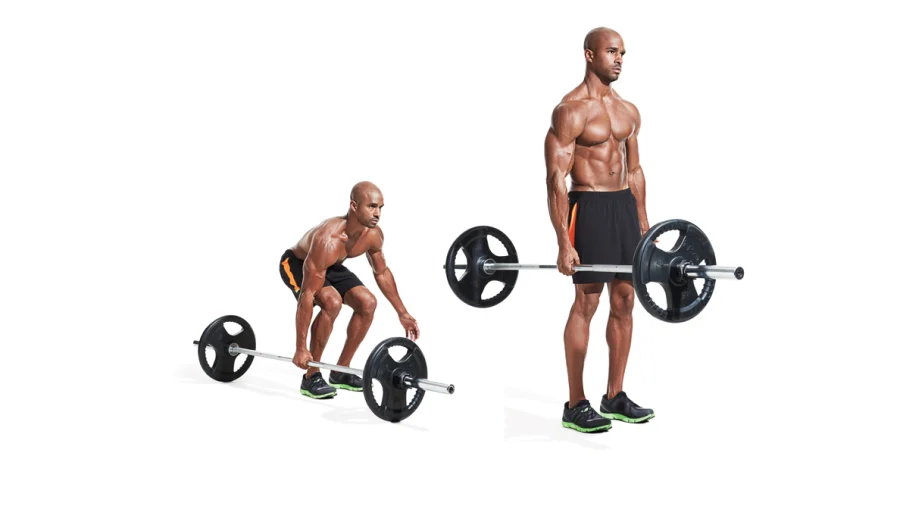
- One of the finest compound exercises for building significant muscular development and strength in your back (as well as your hips and hamstrings) is the deadlift.
- Deadlifts provide a unique training stimulus that surpasses other exercises by applying moderate to high weights to your back.
- Your rhomboids, lats, or traps.
- While your back muscles don’t immediately affect the deadlift’s range of motion, their engagement is crucial for supporting the weights required for growth while protecting your spine.
How to Do It
- Place your feet shoulder-width apart, your hips back, and your back flat as you face a weighted barbell.
- To ensure a firm grasp on the bar, bend your knees slightly more than your shoulder width.
- As you load the pull, keep your chest high and your back flat.
- Tighten your back muscles and extend your arms.
- Keeping everything engaged, forcefully drive your legs into the ground while simultaneously raising your shoulders and chest to
- elevate the hip bar.
- Even if you are aiming to develop your back, while you execute deadlifts, let your shoulders hang down and don’t shrug.
- Reps and Sets: Go hard.3 sets of 3–5 repetitions should be started.
Pull-Up
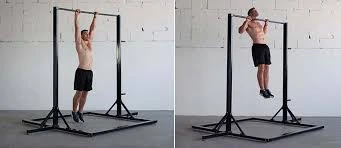
- Because the pull-up is a bodyweight exercise, don’t assume it’s less effective than the other exercises on this list.
- Your core muscles are called upon to provide stability as you pull your own body weight, causing instability.
- Additionally, pull-ups might be really exciting if you’re heavier.
- Finally, it’s always convenient when you only need a little gear to engage in vigorous exercise.
How to Do It
- Take up an overhead hold on the bar that is just a little bit broader than your shoulder.
- Pull-ups are started by contracting the core and upper back while maintaining a relaxed arm position and raised shoulders to the ears.
- Drive your shoulders away from your ears and try to get your chin up to or above the bar.
- Try to stop for a beat at the peak of each rep to increase the difficulty of the normal pull-up.
- Reps and Sets: Aim for a high repetition count.
- When you can perform fifteen or more pull-ups, you should think about adding weight.
Bent-Over Row
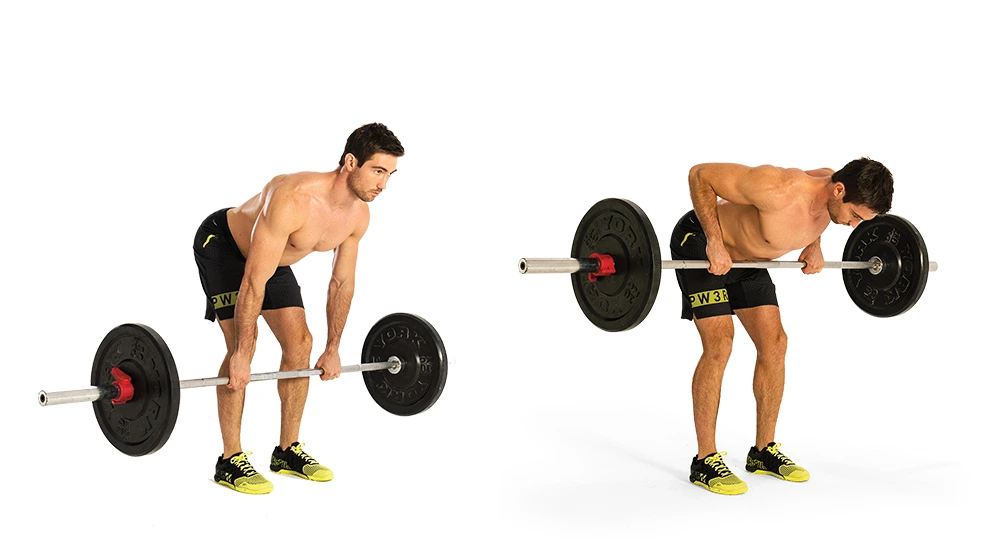
- Bent-over rows provide a great deal of exercise variety.
- You can row kettlebells and dumbbells if you have access to them, or you can just do the standard barbell variant.
- You may effectively activate your whole posterior chain, from the hamstrings to your stomach, by hinging at your hips to row the weight to your stomach the snares.
- Most back workouts start with some variation of rows of some kind.
How to Do It
- Position yourself in front of a weighted barbell with your feet shoulder-width apart, just like you would for a deadlift.
- Once your body is roughly parallel to the floor, hinge at the hips.
- Take a little broader grip than you would normally use for a deadlift when grabbing the barbell.
- When you row the barbell, lead the pull with your elbow until it hits your abdomen.
- Lean back so that your weight is on your heels press the button.
- Wearing a lifting belt is nothing to be ashamed of if your lower back strength is keeping you from doing more.
- Reps and Sets: Here, aim for moderate repetitions without sacrificing force.
- Try four sets of eight.
Chest-Supported Row
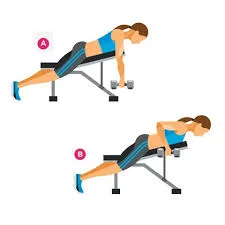
- The crucial component of this row variant is the chest support:
- It eliminates the possibility of momentum and forces you to provide an external support framework to brace against in order to depend just on your muscles to shift the weight.
- This exercise separates your back muscles, allowing you to fully engage them.
- Additionally, it relieves pressure on your lower back because you are not required to maintain yourself in an erect posture.
How to Do It
- Lay face down on a weight bench adjusted at a 45-degree angle so that your stomach and chest are supported.
- Raise each dumbbell to your sides until your elbows cross your body, then grab one in each hand.
- Reduce the weight gradually and under control.
- During your reps, firmly press your chest against the support structure.
- Keep in touch throughout the whole thing.
- Sets and Reps: Aim for greater repetitions while maximizing the chest support. Aim for three sets of twelve to fifteen repetitions.
Single-Arm Row
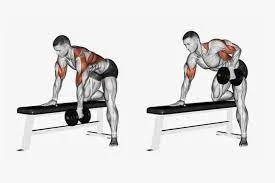
- One unilateral row variant that can strengthen your upper back and support hypertrophy is the single-arm dumbbell row which rectifies imbalances in the muscles.
- Whatever your fitness objectives, you should definitely incorporate at least one single-arm workout into your routine during your cycle.
- It can also aid in strengthening the arms and grip.
- This practice has a few versions, but the most often used one involves you using the free hand to row a dumbbell and support the same-side knee and arm on a weight bench.
How to Do It
- Place a bench next to you such that it is parallel to you.
- Plant your second foot firmly on the floor and place your same side hand and knee on it using your free hand, extend downward, and seize a dumbbell.
- Maintain a flat back and a neutral head posture.
- Dumbbell rowed to your side till your elbow clears your body.
- Refrain from rotating your torso at the peak of each movement.
- Reps and Sets: Given that you’re just utilizing one arm, exercising with high repetitions will probably be more beneficial.
- 3–4 sets of 10–12 should be started reps.
Inverted Row

- By executing the inverted row, you may reverse the script and pull yourself to a fixed bar instead of having a barbell row to you.
- This exercise works your back, especially the lats and middle trapezius muscles, and is incredibly effective while remaining deceptively difficult.
- However, because you’re not rowing your entire body weight, the inverted row is usually easier to perform.
- For those just starting out, this is a great way to develop back strength and control of the body.
How to Do It
- To ensure that a bar is sturdy and supported, place it within a rack.
- When you lie down beneath the bar, your hands should just be able to touch it.
- As necessary, adjust the height.
- Take a tight hold of the bar and arrange your body like a hard plank.
- Try to maintain your elbows tucked in at your sides as you pull your chest toward the bar.
- It’s simpler to row if you have your feet on the floor. Lift your feet to make the task more challenging.
- Reps and Sets: Row for high repetitions if you’re not utilizing an external weight.
- Try to complete two or three sets of ten to fifteen reps.
Renegade Row
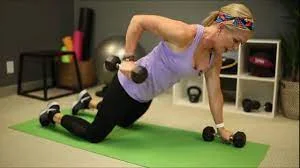
- Exercises for the back shouldn’t be limited to only the back.
- Your body is made to function as a single, coordinated unit, coordinating the actions of several joints and muscle groups simultaneously.
- During your back exercises, you may intensify this synergy by using an activity like the renegade row.
- There is a 2-for-1 in the rebel row.
- It strengthens your back and tests your core stability with its alternating movement pattern.
- Imagine doing a plank plus a dumbbell row to provide significant back-to-front stimulation.
How to Do It
- Take a straight-arm plank posture, but instead of placing your hands on the floor, grasp a set of dumbbells.
- Once your upper arm is parallel to your body, brace your core, take a breath, and row one weight up.
- Row the other weight in the same manner, lowering that arm back to the ground and bracing once again.
- As much as possible, try not to rotate your torso when rowing.
- Reps and Sets: Start with three sets of 12–15 repetitions for each arm for a high rep program.
Lat Pulldown
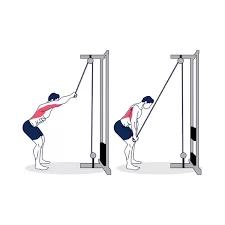
- You pull a bar that is fastened to a cable pulley to your chest during a lat pulldown.
- Your time under stress is increased for more stimulation and growth by the continuous tension of the wire.
- For those who are still unable to perform a pull-up, this is a great alternative.
- With the exception of the fact that you’re seated, a pulldown is quite similar to a pull-up in that you don’t have to begin with your whole body weight.
- This exercise is excellent for building up to your first pull-up since it imitates a pull-up.
- Pronated grips also help you work your lats, biceps, and upper back muscles.
How to Do It
- Position your knees beneath the pad and place your hands in a pronated hold on the bar attachment, a little wider than shoulder width.
- Pull the bar down to your chin while keeping your core firm and your torso erect, if not slightly arched.
- As you slowly take up the weight and move back to your starting position.
- Here, a little body language is OK. For optimal stretch, raise your torso back to a vertical posture in between reps.
- Sets & Reps: You may use sets of 6–8 reps to go heavy, or you can use sets of 12–15 reps to really work your back.
Neutral-Grip Pulldown
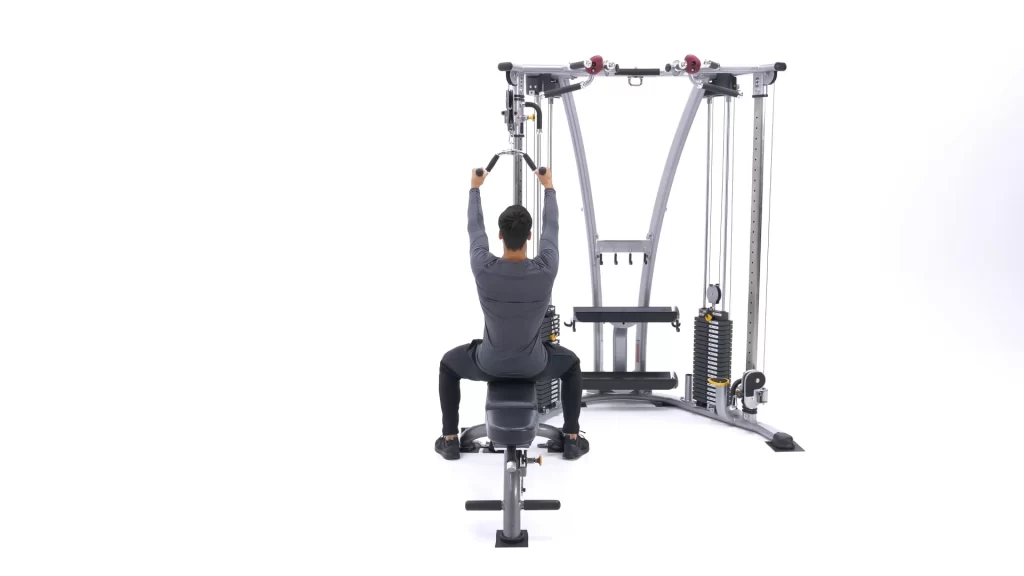
- In this form of the lat pulldown, you pull the attachment to your chest using a neutral grip (palms facing each other).
- This is an additional workout that uses cables and gives you continuous resistance.
- You can more effectively bias muscles like the lats and biceps with a neutral grip.
- By driving your elbows downward more forcefully, the neutral-grip pulldown makes sure your lats do the majority of the work.
- Additional advantages include the capacity to lift larger weights and, for the majority of individuals, a more natural and comfortable grasp posture.
How to Do It
- Assume a cable pulldown position by placing your legs beneath the pad and your hands in a neutral hold on the attachment.
- Pull the attachment down to your chin while maintaining an upright torso and a taut core.
- As you slowly take up the weight and move back to your starting position.
- To get the most out of the exercise, keep your arms close to your body the entire time.
- Sets and Reps: Try 3 sets of 6–8 reps if you want to lift a little bit more weight while maintaining a neutral grip.
Seated Cable Row

- You pull a shoulder-width neutral grip cable connection to your body in this rowing technique.
- The hand posture and arm movement put a lot of mechanical force on your lats, even if the cable lets you benefit from continual resistance.
- This is a great place to start if you want to highlight muscular progress.
How to Do It
- Assume the cable row position, placing your hands on the foot platform and your feet on the attachment with a neutral grip with the body angled slightly forward at the hips and a taut core.
- Draw the attachment toward the direction of the upper abdomen.
- During each repetition, tuck your shoulders slightly forward and lean forward.
- Sets and Reps: You may program this exercise in a variety of ways, but to get started, just do three sets of eight repetitions.
Wide-Grip Cable Row
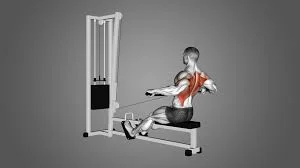
- Getting your upper back isolated isn’t always simple.
- In this kind of rowing, you pull an attachment toward your chest while extending your elbows.
- With this minor technique modification, your upper back should be performing the majority of the effort.
- In this version, your arm path will be higher than the sitting row targeting your lats, which will line up the rowing action with the traps, and rhomboids, and teres your rear delts and upper back muscles.
How to Do It
- Place your hands on the attachment and place your feet on the foot platform to take a position in the cable row station.
- overhand grip.
- Pull the attachment toward the top of your chest while maintaining an erect torso and a firm core.
- Reposition your arms behind your body.
- Consider using your elbows to lead and maintaining a flared-out position at all times.
- Sets & Reps: Aim for greater reps of 12 or more because your strength is a little bit limited here.
Dumbbell Shrug

- Use a conventional shrug to exercise your traps with free weights.
- One of the few back isolation exercises that may also be used to raise large weights is the dumbbell shrug.
- Your traps are really strong muscles that can support a great deal of weight, especially the upper fibers.
- Teach them appropriately.
- You may isolate your upper traps with shrugs to build hypertrophy or strength.
- Furthermore, performing shrugs while gripping a set of heavy dumbbells can naturally strengthen your grip.
- Alternatively, you can remove your grasp completely by grabbing some lifting straps.
How to Do It
- Place your feet beneath your hips and hold a moderate-to-heavy dumbbell in each hand while standing erect.
- Slightly bend forward and let the weights drop freely while keeping your arms relaxed.
- Quickly lift your shoulders and tense your traps.
- For a beat, maintain the top spot.
- Try shrugging up and back to activate your trapezius muscles completely.
- Reps and Sets: Use greater reps of 12 or more, as your range of motion is limited.
Cable Rope Pullover
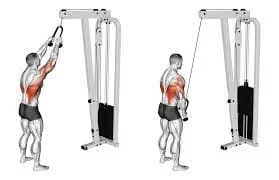
- It is not necessary to only perform complex exercises if you want to develop your back.
- Similar to the cable rope pullover, isolation lifts may be used with a more delicate touch and still be just as helpful for growth. Dumbbells can be used for pullovers, but cables will offer far more even mechanical tension across the whole range of action.
- Anywhere you have access to a cable and rope attachment, you may do this variant.
How to Do It
- Position yourself before a cable pulley, keeping your hands on the rope or strap attachment and your feet flat on the ground.
- As you pull the attachment down and back toward your hips, force the upper arm down while maintaining a small forward lean, a taut core, and a stiff torso.
- Maintain an outward rotation of the shoulders and point your inner arms toward your head.
- Reps and Sets: Aim for higher repetitions, up to 15 reps in 2 or 3 sets.
Landmine Row
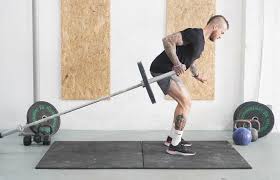
- Standard barbell training is given a distinctive twist by landmine workouts.
- With this version, you can load up on some heavy weight and also create stress over your entire back.
- Depending on your goals, you may execute the landmine row at different rep ranges, and test your lower back strength and core stability.
How to Do It
- You may position your barbell by either wedging it into a wall corner or by slipping it into the landmine attachment sleeve.
- Place your working hand over the barbell’s shaft while standing next to it.
- Using the bar’s end as support, stand up and then bend over.
- The bar’s end should be rowed into your hip just like a dumbbell.
- Refrain from applying too much momentum in this situation.
- Reps and Sets: Try lesser reps because you can lift large weights.
- Try four sets of six or eight.
Farmer’s Carry

- Known for producing practical, everyday carrying strength, the farmer’s carry is an unmatched training aid that strengthens the back.
- The farmer’s carry enhances your postural strength and control while strengthening your grip and core stability.
- Additionally, you may perform them wherever you have access to weights and a clear area for movement.
How to Do It
- Locate a spot that is open and grasp a pair of dumbbells, kettlebells, or even a trap bar.
- Focus on stability and distance traveled as you move in a straight line with steady, deliberate steps.
- Reduce the length of time your feet are off the ground by taking tiny, low steps.
- Reps and Sets: Here, you should walk for time or distance rather than counting repetitions.
- A couple of rounds of 10- to 15-second bursts should be started.
Y-Raise
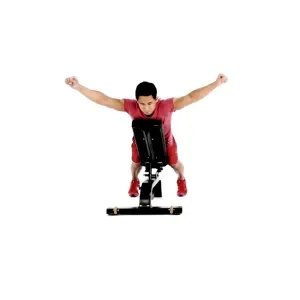
- Your trapezius is a tripartite muscle.
- The most noticeable traps are the upper ones, which run up into your neck from your shoulder blade and spine.
- Although they are more difficult to isolate, your middle and lower trapezius muscles are just as vital to training.
- You need to perform an activity like the Y-raise to go to those places.
- The Y-raise gets a lot out of little: You might not even need to utilize weight at all if you’re not used to using your lower traps.
- You may practice shoulder flexion with this exercise without allowing your upper traps to take over.
How to Do It
- Hinge at the hips or place your torso on a weight bench that can be adjusted to an inclination of 45 degrees.
- Lower your arms to a loose hanging position.
- Sweep your arms forward and forth until they align with your trunk, keeping your elbows straight.
- Your arms and body should create a “Y” at the top of each repetition, as seen from above.
- Reps and Sets: Here, try two or three sets of up to twenty repetitions.
Straight-Arm Pulldown
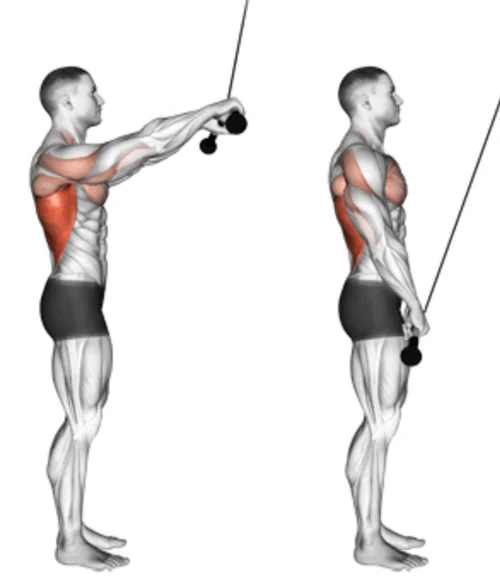
- Because there are so many distinct muscles in your back, it might be difficult to isolate them for growth.
- As near to a true “isolation” as you can get for working the lats, the biggest muscle in the back, is the straight-arm pulldown.
- The straight-arm pulldown is an excellent exercise for growing muscle because of its wide range of motion, consistent tension
- provided by the cable pulley, and easy learning curve.
- A larger range of motion is produced for longer periods of tension during the straight-arm lat pulldown workout due to its unique
- torso angle, which sets it apart from other exercises like the lat pulldown and seated cable row.
How to Do It
- Connect a straight bar, EZ bar, or rope handle to a cable pulley that is adjusted to the highest setting.
- Retrace your steps to the point where you can straighten your arms without any slack in the cable and bend your body forward 45 degrees.
- Pull the rope to the tops of your thighs while bending your elbows just a little bit.
- You may be able to achieve a greater lat stretch or connection by bending forward.
- Reps and Sets: Aim for two or three sets of twelve to fifteen repetitions.
Kroc Row
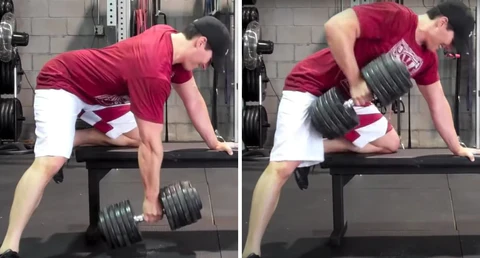
- The Kroc row gets its name from Janae Marie Kroczaleski, a bodybuilder and powerlifter who once combined her bench press, squat, and deadlift total of 1,095 kilograms (2,414 pounds) during a powerlifting competition.
- Which Complete Bodybuilding Workout Is Best for Novice to Experienced Lifters?
- The idea is straightforward: Select a dumbbell that is marginally heavier than your usual rowing weight, and then utilize a small body of English to do as many repetitions as you can.
- Your back will undoubtedly expand and get stronger from the heavy, high-volume rows.
How to Do It
- Locate a heavy dumbbell and roll it in front of a dumbbell rack, preferably away from traffic.
- Stun the other leg back while bracing one arm on the rack.
- Turn to face the dumbbell and use your free hand to grasp it.
- Now, purposefully use momentum to row your elbow beyond your torso.
- It is recommended to use lifting straps for this rowing variation.
- You don’t want to be constrained by your grasp.
- Reps and Sets: “Adequate” Kroc row programming consists of several sets of 15–20 intense repetitions.
Pendlay Row
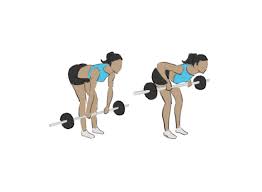
- Developed by the late weightlifting instructor Glenn Pendlay, this dead-stop rowing variant gives the normal barbell row extra explosive force by requiring you to halt with the weight on the floor in between reps.
- The pause has two purposes: it reduces strain on your lower back, which might become fatigued from continuously rowing weight in a hinge position, and it allows you to develop your force production and power output capability.
How to Do It
- Assume the standard deadlift position in front of a weighted barbell: feet shoulder-width apart, shins resting against the bar.
- Your torso should pivot forward until it is parallel to the floor.
- Use a hold on the bar that is somewhat broader than your shoulder width.
- Row the bar explosively to your stomach while bracing your core.
- Return the bar to the floor, take a moment to gather yourself, and then begin the next repetition.
- Don’t be scared to make firm contact with the bar with your chest during a row in order to produce the most power possible.
- Reps and Sets: As this is a power movement, don’t overdo the repetitions.
- Execute three sets of three to six people.
Face Pull
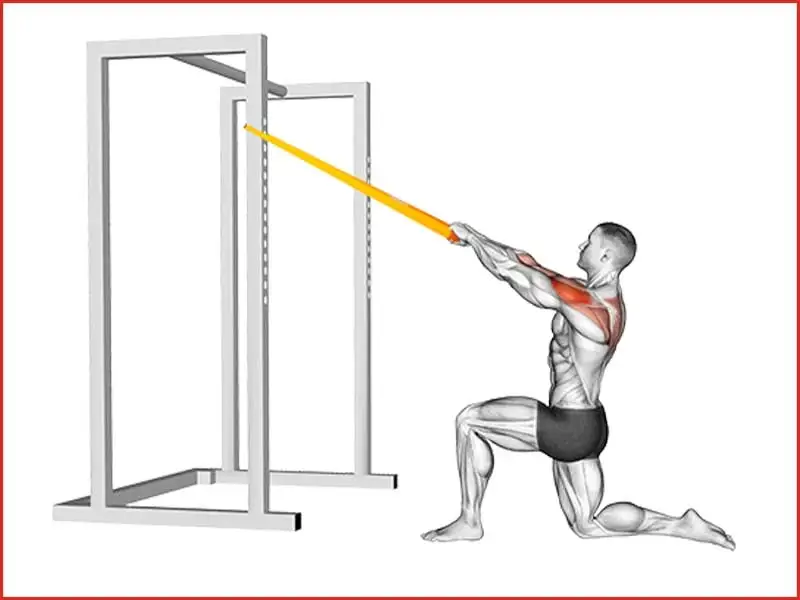
- It’s not just about size and power.
- Even the smallest muscles and joints must be strong and sturdy to enable powerful lifts.
- Introducing the face pull, an exercise that helps you maintain good posture and shoulder joint mobility by contracting your rhomboids, rear delts, and traps.
- Take it easy with this exercise and don’t expect to gain a ton of muscle.
- In the weight room, you must “eat your vegetables” by doing efficient prehab exercises.
- Therefore, the next time you train, do yourself a favor and grab a forkful of face pulls.
How to Do It
- Attach a rope attachment to the highest setting of a cable pulley.
- With both hands, palms facing each other, hold onto the rope.
- Retrace a few steps to ensure that the rope is taut.
- Lift your hands until your face is level with the rope.
- Pull the rope in the direction of your face while simultaneously flinging your elbows back and forth.
- The motion ought to resemble the front double biceps posture.
- As you pull, consciously turn your shoulders outward so that your arms point front.
- Reps and Sets: Here, high repetitions are quite juicy; perform up to 20 reps in numerous sets.
Seal Row
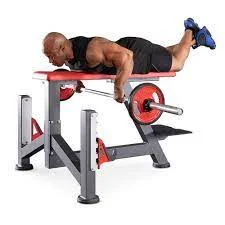
- In the seal row, you lie on a flat bench and row a weighted barbell.
- The back muscles bear all of the responsibility as momentum is eliminated from the situation.
- One drawback is that it might be difficult to mount a flat bench on a couple of bumper plates and have a friend deliver the barbell unless you have access to seal row-specific equipment.
- If you want to row heavily, though, this action is great for saving your lower back.
How to Do It
- Bumper plates should be layered above a flat-weight bench, with a stack at either end of the bench.
- Raise the bench to a level where the weights stay off the floor when you’re lying down and extending your arms.
- Ask a workout buddy to give you a dumbbell or barbell to test your core and glutes.
- When the weights are in contact or next to the bench, row them.
- Pull with your elbows leading the way.
- Return the weights to the beginning position gradually.
- Half the fight is won during setup.
- Make sure you position yourself so that you don’t obstruct other customers throughout this maneuver.
- repetitions & Sets: Begin with three to four sets of eight to ten repetitions.
Meadows Row
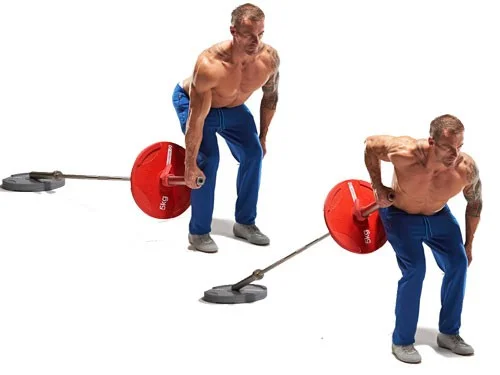
- You must row a barbell in a landmine attachment with one arm in this unusual rowing variant.
- This exercise, named for the late bodybuilding athlete and coach John Meadows, is an additional alternative for back development that you may perform with just one arm.
- The muscles in the upper back, such as the rhomboids, traps, and other smaller tissues that articulate the scapula, are the focus of this particular row.
How to Do It
- Place the front foot perpendicular to a barbell that is inserted into a barbell sleeve while maintaining a staggered stance.
- Hold the bar with an overhand hold while bending at the waist.
- Make sure the hip nearest the bar is higher than the front hip as you rest the elbow on your front leg.
- Raise the weight till the end of your hand is outside of your chest. Repeat after lowering the weight back down.
- At the peak of each exercise, hold the position for a brief while to highlight the scapular.
- Reps and Sets: Higher reps are achieved with one-armed lifting.
- Perform two or three sets of twelve to fifteen repetitions.
Back Hyperextension
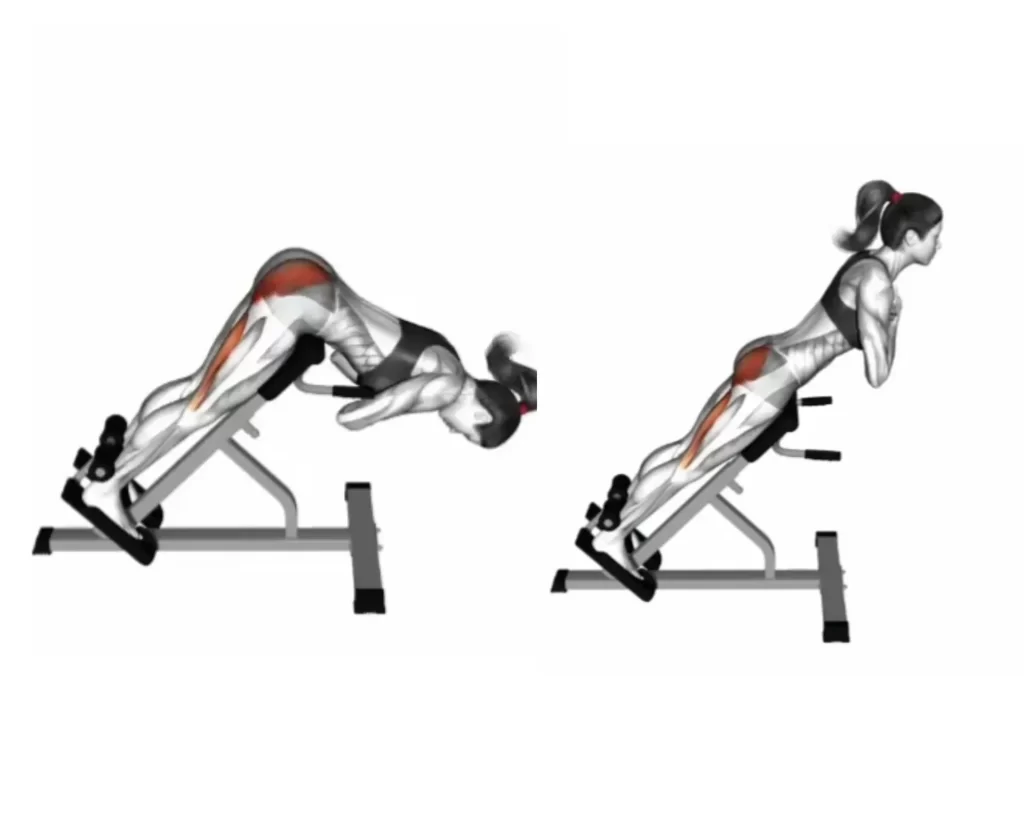
- Lifters frequently abandon lower back-specific workouts in favor of increasing their rows and pull-ups.
- In actuality, strengthening your core and general postural stability needs lower back exercise, which isn’t really glamorous.
- To activate your erector spinal muscles, perform the back extension by simply hinging at the waist while your legs are resting on thigh pads. These can be performed with a weight plate held to your chest, or, as is more common, only your body weight.
How to Do It
- Make sure your Achilles tendon is directly beneath the ankle pad by pressing your leg up against the pads of a back extension machine.
- Fold your arms over.
- Hinge forward gradually until your body is at a ninety-degree angle.
- To return to the beginning posture, contract your hamstrings and glutes.
- To draw attention to your lower back, don’t be scared to deliberately curl and uncurl your spine.
- Sets and Reps: Here, higher reps are quite beneficial. Try two sets of fifteen to twenty repetitions, or twelve if you’re using more weight.
High Pull
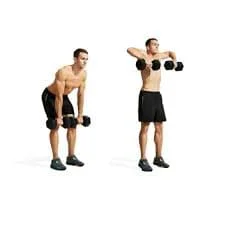
- It’s not always necessary to be deliberate and in control during back training.
- If you loosen up a little with a high-pull workout, you may add a ton of muscle and transform your body.
- With a high pull, you essentially do a modified version of an Olympic lift by using your entire back to quickly direct and raise a barbell. While heavy lifting has its benefits, your back training truly starts to shine when you incorporate speed into the mix.
How to Do It
- You can lift from what weightlifters refer to as the hang position, which involves tipping over at the waist and letting the barbell fall down your leg until it reaches around the height of your kneecaps.
- You can also execute high pulls with a barbell on the floor.
- Although pulling up from the floor should allow you to use more weight, hanging high pulls are simpler to string together for several repetitions.
- Legs first, press into the floor, then quickly rise to a standing posture.
- At the peak, simultaneously stretch your hips, knees, and ankles to use your momentum to raise the barbell.
- Pull firmly with your arms and shrug your shoulders as the barbell rises. Pulling the bar up to around your sternum’s height should be possible.
- Follow it as it descends to go back to where you were.
- Allow your legs to raise the bar on their own before using your upper body to pull.
- Reps and Sets: Try doing three to five sets of three to six repetitions for the explosive high pulls.
Power Clean
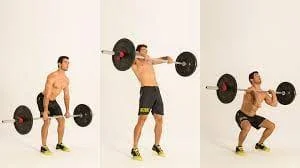
- All levels of athletes use the power clean to increase their own strength, whether it’s in the Olympic training hall or virtually any high school weight room worldwide.
- Not to mention, the power clean is an underappreciated upper-back builder.
- You make up for any lack of regulated eccentric tension with lightning-fast muscle contractions and a powerful trap pump.
How to Do It
- Assume a modified standard deadlift starting stance, with the bar over the center of your feet, your hips slightly down, and your knees in front of the barbell at the beginning.
- Proceed to press down with your legs to break the bar off the floor; your knees should automatically move out of the way.
- Persist in exerting pressure until the bar ascends effortlessly, flowing between your thighs.
- Explode by simultaneously stretching your whole lower body as the bar hits mid-thigh.
- This will raise the standard in the field.
- Afterward, use a high front squat stance to grab the bar.
- As soon as you get the bar, you might wish to spread your feet apart.
- Consider your back to be the framework that allows you to have power when cleaning.
- Instead of pulling with your arms, keep your upper back stiff the entire time.
- Sets & Reps: Perform a few sets at a moderately high volume. Try doing 4–5 sets of 3–4 repetitions.
Back Warm-Up
- Without causing undue tiredness, a well-planned warm-up helps lower the chance of injury and increases preparedness for your training session.
- Readying for the next training day can be enhanced by elevated body temperature, an active (stimulated) neurological system, and a prepared mental state.
- A treadmill user getting warmed up.
- Bestsenny Artem / Shutterstock
- The workouts you are doing in that day’s training session are going to be one of the best warm-ups for any muscle group.
- If you’re performing pulldowns, for instance, you may warm up with some mild repetitions and build up to your working sets.
- This lowers the chance of injury and enhances your overall training performance by guaranteeing that the right muscles and joints are being stimulated.
Sample Back Warm-Up
- Although minimalism is beneficial, if you have more time, you should take the opportunity to warm up your back more thoroughly and perform a better workout as a consequence.
- Here’s an example of a thorough warm-up routine that you may follow as soon as you walk into the gym:
- Five to ten minutes on an elliptical, stair stepper, rowing machine, or treadmill.
- Two dead hang pull-ups in 15 seconds each.
- Straight-arm pulldown with Cable or Band: 3 x 20 with minimal resistance.
- After that, perform one to three light-weight warm-up sets of your first exercise.
How To Train Your Back
- Much of your upper body is covered by the muscles in your back.
- Because of this, you should either exercise your back alone, in conjunction with a muscle that opposes it, like your chest, or on the day that you perform a deadlift.
- These are three standards for your back exercises; you may choose how to include them in your program.
Sets and Reps
- For someone seeking to expand their back, somewhere between 12 and 18 sets per week is probably a fantastic place to start.
- More experienced athletes may perform more than 18 sets a week if they want to prioritize developing one area of the back over another.
- Each of the three to four exercises should have an equal number of training sets.
- For equalized growth and stimulation, aim for a one-to-one ratio of vertical pulls to horizontal pulls (vertical pulls being motions when your body is erect).
- A cable rower.
- Recall that you can only do so much in a single workout and remain productive.
- A day later in the week may be a good time to divide up the training volume if you see a decline in your performance.
- It has been suggested that two to three exercise sessions each week would aid in optimizing muscular growth.
Back Training Tips
- The human body relies on the back muscles for several structural and functional processes.
- There are a few guidelines that you may follow while exercising your back to grow or get stronger in order to maximize your results and minimize your chance of injury.
Benefits of Training Your Back
- Your legs are sometimes referred to as your foundation.
- That analogy makes sense, yet the structure is held together by your back.
- Your spine is supported and stabilized by your back muscles.
- You wouldn’t be able to work with a barbell or even stand up straight without the support of your lats, rhomboids, traps, and spinal erectors.
More Back Training Tips
- This list is by no means exhaustive, even if these items span the whole back.
- A wealth of back training knowledge is just waiting to be discovered.
- Here’s what to read next for you:
- Seven Weighted Back Exercises That Don’t Include the Deadlift
- Which Is Better for Strength, Hypertrophy, and Fitness: Barbell or Dumbbell Rows?
- Four Lower Back Strengthening Exercises.
Conclusion
Back exercises are simply beneficial! Strong back muscles are associated with improved health; however, exercise caution as improper form can have the reverse impact and exacerbate pre-existing conditions.
Low back pain can be effectively treated with back training regimens that incorporate strengthening, flexibility, and aerobic components. Increasing the range of motion and supporting the patient’s functional movement is made easier by strengthening the surrounding tissues’ muscles and improving their flexibility.
FAQ
Exercises like swimming, biking, and walking may help relieve back discomfort.
Begin with brief sessions and gradually increase in length.
Try swimming, where the water supports your body, if you’re experiencing back pain.
The deadlift
Furthermore, pullups train your biceps and forearms in addition to your back, which helps to strengthen your shoulder.
The deadlift is still the gold standard of back workouts since it works your whole posterior chain in addition to stabilizing your lat and core.
The foundation for achieving maximum growth and success in training is a strong back. Having a stronger back will improve your posture, make your exercise more sustainable, and reduce your chance of injury. In short, having a strong back will help you: Reach your maximum strength.
The Good Morning Exercise: How to Perform It and Why You Should ISSA
To carry out the morning exercise:
With your feet shoulder-width apart and your knees slightly bent, take a straight stance.
As you slowly bend forward at the hips, push your hips back as though you’re closing a door with your butt.
Once your upper body is nearly parallel to the floor, keep bending forward.
In general, the muscles in the back are stronger than those in the chest.
This is a result of the increased usage of the back muscles in routine tasks like reaching up, bending over, and moving heavy items.
References:
- Issn-Ciss, A. C. N. (2023, September 19). The 25 Best Back Exercises for strength and muscle gain. BarBend. https://barbend.com/best-back-exercises/
- M. (2020, September 23). Back Attack | 6 Must-Do Back Exercises For Mass – MYPROTEINTM. MYPROTEINTM. https://www.myprotein.co.in/blog/training/6-must-do-back-exercises-mass/






